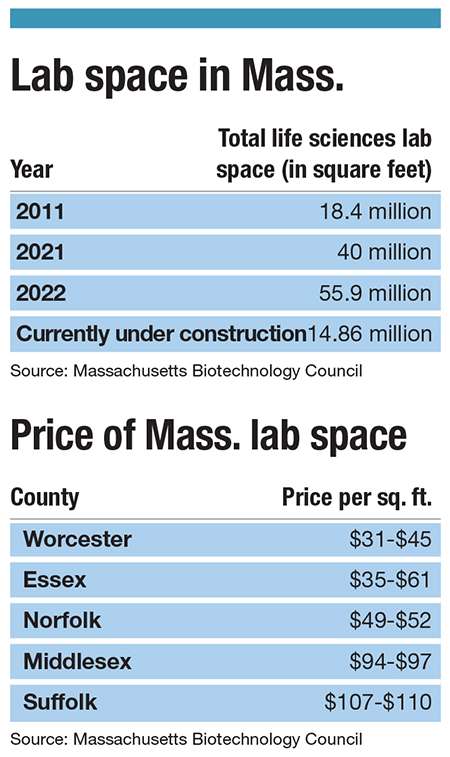
WPI’s CERES lab offers researchers and companies the opportunity to access expensive, hard-to-find equipment
 Photos | Courtesy of Worcester Polytechnic Institute
Kenneth Dwyer, lab manager at the CERES lab, operates a CytoFLEX 5 system machine.
Photos | Courtesy of Worcester Polytechnic Institute
Kenneth Dwyer, lab manager at the CERES lab, operates a CytoFLEX 5 system machine.
Kenneth Dwyer leans forward when he walks. He turns and faces me as he talks and walks, selling the high points of the Cell Engineering Research Equipment Suite laboratory at Worcester Polytechnic Institute he’s charged with managing and opening to the public for use.

Dwyer nearly bangs into a cart as he maneuvers around a table of breakfast food put out for students who are being trained in another series of labs on the floor where CERES is located. Dwyer almost walks into a rack of laboratory coats but catches himself, spins round again, and hunches forward, propelling toward the laboratory door. He’s still talking, arms outstretched, moving and gesturing. Excitement rises in his voice. He gets more animated as he gets closer to the door. He stops and pulls the handle open.
Inside, there’s a low-level hum and a bunch of computer-tower-looking machines that could pass for a NASA computer 10 years ago. And they are computers, but they’re not trying to lift a rocket into space. Instead, they’re reaching into cells and extrapolating data. The machines in here don’t look like the old science classrooms or even the classrooms we see in movies. Instead, it’s sterile and more like a command center. These machines aren’t for experimentation; they’re to see if your experiment works.
“An amazing amount of data,” Dwyer said when pointing at one of the machines.
That data is invaluable for small companies, students, and entrepreneurs interested in cell therapy. The fee-for-use lab and its machines can be rented by interested parties after a training session. And without that kind of access, some of these upstarts wouldn’t be able to move on to the next stage of funding, research, or investment because the machines cost into the hundreds of thousands of dollars. Searching for them on the Internet and the cost of opening a lab that only spits out data – it doesn’t even do the experiments – becomes mind-numbing. One of the machines, a Bio-Rad QX200 Droplet Digital PCR System, which is a fancy testing machine for laments, costs upwards of $114,392.
A college-incubator partnership
Eric Young is an assistant professor in the bioengineering department at WPI, and he and other faculty need the equipment as well. Faculty had asked the school to fund the lab space as they started to look more into gene therapy and other cell treatments, but it was too expensive. In came the Massachusetts Biomedical Initiatives incubator, and a partnership was formed.
The CERES lab was funded by a 2020 Open Capital Award from the Massachusetts Life Science Center. WPI received $877,314 from former Gov. Charlie Baker’s administration for the equipment. As part of the deal, a partnership between WPI and MBI was formed to design and create the space.

“The CERES lab and other labs like it make equipment accessible, “ said Jon Weaver, MBI president and CEO.
A lot of the equipment in the lab is specific and because of that, it’s hard to get. “A droplet PCR system is usually only for larger companies,” Young said.
Take, for example, the CytoFLEX 5 system in the lab. It sorts cells and has four laser-flow cytometers and cell sorters, enabling a scientist to sort cells to collect data. It looks a lot like a laser printer, but inside the box, it’s a high-powered machine that will spit out paper-ready data to be used by a company to hit its research benchmark or prove its hypothesis; and thus move onto the next stage in funding.
The reason a lot of this equipment is so expensive and so hard to come by is because it’s new. The technology still hasn’t filtered out into the market, so it hasn’t become more common nor replicable on a larger and more affordable scale.
“When I was a little kid, microwaves were expensive. Now, they’re a lot cheaper,” Young said.

Building more space
The other reason is this specific type of lab space is still difficult to come by outside of Cambridge, Boston, and the Route 128 belt. According to a Newmark Group report for the fourth quarter, there were 1.15 million square feet of life science buildings in the I-495 market (Newmark did not have a similar number for Greater Worcester) and 2.2% was vacant in the fourth quarter. Compare that to Cambridge, which has 3.85 million square feet of space with 6% vacant and another 3.03 million under construction. It's easy to see why it's hard to find a place to house the kinds of machines that WPI is offering.
There is more possibility for lab space. Pembroke construction firm Acella Construction Corp. in March competed turning an old library at Clark University in Worcester into two laboratories with offices, conference rooms, and a student lounge. Acella is in the process of completing another 980-square-foot lab for $1.2 million on campus as well. Ryan Lavangie, vice president of sales and marketing at Acella, and Eric Garber, a project manager, said the company is seeing more lab construction work in Central Massachusetts, and the company’s expansion to working at Clark was a way for it to branch out into the growing market.
So, like the microwaves and televisions of the past, for now people will have to share the expensive equipment and space at a lab like CERES, becoming an important cog in the life science ecosystem moving forward.














0 Comments